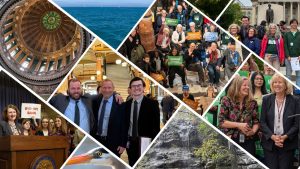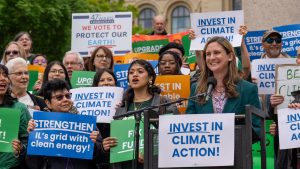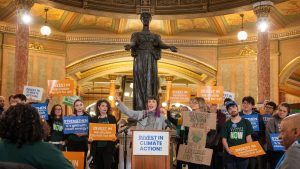Transportation
With 139,000 miles of roadways – the 4th most in the U.S. – Illinois is a major player in the nation’s interstate travel and transportation.

Renewable energy
Illinois is on track to get 25% of its renewables by 2025

energy efficiency
Consumers get the same services for less money

fossil fuels
Burning fossil fuels harms our health and environment

transportation
The transportation sector is now the largest carbon emitter
Roads and Bridges in Illinois
Freight and Passenger Rail in Illinois
Current Transportation Laws
Designated by the federal government as the Chicago region’s Metropolitan Planning Organization, CMAP is responsible for reviewing and approving projects that use federal transportation dollars. Part of this role entails overseeing the implementation of the GO TO 2040 comprehensive regional plan, which was created to address anticipated population growth of more than 2 million new residents.
NEPA requires that agencies take a hard look at how proposed transportation projects involving major federal action significantly affect the human environment. Agencies are to draw upon public participation to highlight and seriously consider comprehensive environmental, cultural and agricultural impacts in deciding whether and how to build projects like new highways and rail lines. While agencies are not required to select the most environmentally conscious alternative, NEPA injects policy considerations into the transportation planning process, which can result in preserving and protecting rare and important natural resources.
The Regional Transportation Agency is charged with transit planning for the six-county Northeastern Illinois region. The agency’s responsibilities include implementing projects, administering grant programs, growing ridership, and improving mobility. RTA also provides technical and analytical expertise in support of local public transit initiatives to municipalities and transportation agencies across the region. Many of these efforts are geared towards creating and preserving livable communities throughout Northeastern Illinois.
The region’s system covers approximately 3,700 square miles and serves approximately 8.4 million residents. The RTA’s regional system is the second largest transit system in the country by passenger miles traveled, behind only New York, and the third largest in the country by ridership, behind only New York and Los Angeles.
Passed in 2013, this act creates the South Suburban Cook County Brownfield Redevelopment Zone with the goal to redevelop brownfields (former industrial or commercial sites where future use is affected by environmental contamination) in the zone by leveraging the existing infrastructure around the CN Intermodal Terminal and the Union Pacific Intermodal Terminal.
Eligible projects are limited to those classified by the Urban Land Institute as: warehouse distribution, manufacturing, or freight forwarding. Eligible developers may be reimbursed for a variety of activities, including: environmental studies and remediation; land acquisition and demolition; recruiting and training minority residents from the zone; and upgrading the public infrastructure.
The Act has created economic opportunity and reinvestment in communities, jobs, and new industry in the suburbs.
Protecting Cyclists and Pedestrians from Harassment
As of 2010, this law makes it a crime to ride unnecessarily close to, toward or near a cyclist, pedestrian or equestrian. If the violation results in great bodily harm, the driver could be charged with a felony.
The 2008 Bicycle Safety Ordinance
Prohibits motorists from opening a door into moving traffic; sets a 3 foot minimum passing distance; and prohibits motorists from turning right in front of a bicyclist.
Illinois Complete Streets
Signed into law in 2007, this important legislation protects pedestrians, bicyclists and other vulnerable road users. Requires that bicycle and pedestrian ways be established in or near urban areas in all state transportation projects.
Transportation Updates
Transit Teetering Over the Fiscal Cliff After Lawmakers Adjourn Without Fixing and Funding Transit
ILLINOIS — On Sunday, the Illinois General Assembly adjourned without addressing Northeast Illinois transit agencies’ $770 million budget deficit, leaving the millions of transit riders who...
Read More >>Wrapping Up the 2025 Illinois Legislative Session
Our team has been on the ground at the Capitol for the last five months, all the way up until the final moments this evening....
Read More >>Activists rally for climate legislation in Springfield during annual Climate Action Lobby Day
Hannah Flath, the senior climate communications manager for the Illinois Environmental Council, said the day gave advocates a unique opportunity to speak directly to elected...
Read More >>As U.S. House Republicans Pass the Most Expensive Anti-Environment Bill in History, Illinoisans Call for State Action on Climate and Consumer Protections
ILLINOIS – Early Thursday morning, House Republicans passed a reconciliation bill that wipes out good-paying clean energy jobs and raises energy costs for families by gutting...
Read More >>A Sprint to Accelerate Illinois’ Clean Energy Progress
With two full weeks of the legislative session left before the May 31 deadline, IEC is working overtime to ensure our priorities cross the finish...
Read More >>Clock counting down to secure state funding before drastic service cuts to CTA, Metra, Pace
A warning has been issued to anyone who takes public transportation in Chicago — with drastic service cuts looming, Illinois legislators only have until the end of...
Read More >>



